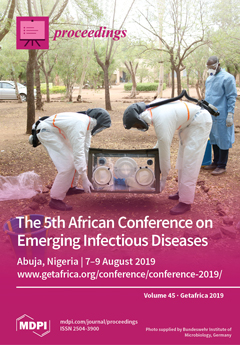Need Help?
Proceedings, 2020, Getafrica 2019
The 5th African Conference on Emerging Infectious Diseases
Abuja, Nigeria | 7–9 August 2019
Volume Editor: Alan Christoffels, University of the Western Cape, South Africa
- Issues are regarded as officially published after their release is announced to the table of contents alert mailing list.
- You may sign up for e-mail alerts to receive table of contents of newly released issues.
- PDF is the official format for papers published in both, html and pdf forms. To view the papers in pdf format, click on the "PDF Full-text" link, and use the free Adobe Reader to open them.
Cover Story (view full-size image):
The Global Emerging Pathogen Treatment Consortium organized the 5th African conference on emerging infectious diseases and biosecurity in Abuja, Nigeria from 7–9 August 2019. The conference was
[...] Read more.
The Global Emerging Pathogen Treatment Consortium organized the 5th African conference on emerging infectious diseases and biosecurity in Abuja, Nigeria from 7–9 August 2019. The conference was an academic and policy-based meeting that addressed the response mechanism to biological threats and increasing incidences of emerging infectious diseases from a continental perspective. The conference confers with the Biological Weapons Convention, United Nations, 1540 Security Council Resolutions, (IHR and PVS).
Previous Issue
Next Issue
Issue View Metrics
Multiple requests from the same IP address are counted as one view.



